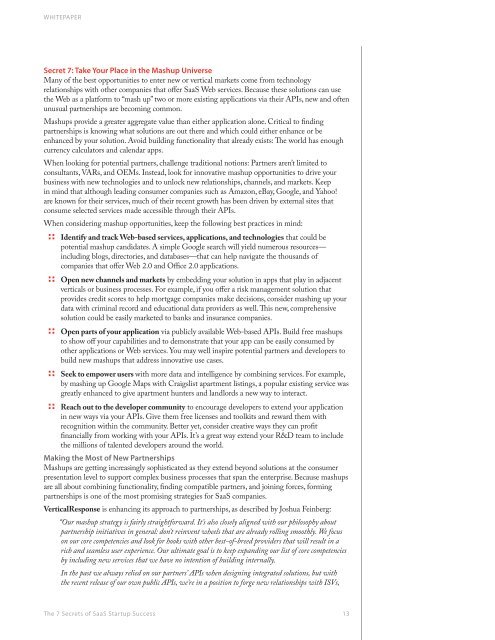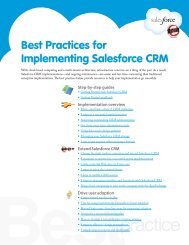The 7 Secrets of SaaS Startup Success - Salesforce.com
The 7 Secrets of SaaS Startup Success - Salesforce.com
The 7 Secrets of SaaS Startup Success - Salesforce.com
You also want an ePaper? Increase the reach of your titles
YUMPU automatically turns print PDFs into web optimized ePapers that Google loves.
WHITEPAPER<br />
Secret 7: Take Your Place in the Mashup Universe<br />
Many <strong>of</strong> the best opportunities to enter new or vertical markets <strong>com</strong>e from technology<br />
relationships with other <strong>com</strong>panies that <strong>of</strong>fer <strong>SaaS</strong> Web services. Because these solutions can use<br />
the Web as a platform to “mash up” two or more existing applications via their APIs, new and <strong>of</strong>ten<br />
unusual partnerships are be<strong>com</strong>ing <strong>com</strong>mon.<br />
Mashups provide a greater aggregate value than either application alone. Critical to finding<br />
partnerships is knowing what solutions are out there and which could either enhance or be<br />
enhanced by your solution. Avoid building functionality that already exists: <strong>The</strong> world has enough<br />
currency calculators and calendar apps.<br />
When looking for potential partners, challenge traditional notions: Partners aren’t limited to<br />
consultants, VARs, and OEMs. Instead, look for innovative mashup opportunities to drive your<br />
business with new technologies and to unlock new relationships, channels, and markets. Keep<br />
in mind that although leading consumer <strong>com</strong>panies such as Amazon, eBay, Google, and Yahoo!<br />
are known for their services, much <strong>of</strong> their recent growth has been driven by external sites that<br />
consume selected services made accessible through their APIs.<br />
When considering mashup opportunities, keep the following best practices in mind:<br />
:: Identify and track Web-based services, applications, and technologies that could be<br />
potential mashup candidates. A simple Google search will yield numerous resources—<br />
including blogs, directories, and databases—that can help navigate the thousands <strong>of</strong><br />
<strong>com</strong>panies that <strong>of</strong>fer Web 2.0 and Office 2.0 applications.<br />
:: Open new channels and markets by embedding your solution in apps that play in adjacent<br />
verticals or business processes. For example, if you <strong>of</strong>fer a risk management solution that<br />
provides credit scores to help mortgage <strong>com</strong>panies make decisions, consider mashing up your<br />
data with criminal record and educational data providers as well. This new, <strong>com</strong>prehensive<br />
solution could be easily marketed to banks and insurance <strong>com</strong>panies.<br />
:: Open parts <strong>of</strong> your application via publicly available Web-based APIs. Build free mashups<br />
to show <strong>of</strong>f your capabilities and to demonstrate that your app can be easily consumed by<br />
other applications or Web services. You may well inspire potential partners and developers to<br />
build new mashups that address innovative use cases.<br />
:: Seek to empower users with more data and intelligence by <strong>com</strong>bining services. For example,<br />
by mashing up Google Maps with Craigslist apartment listings, a popular existing service was<br />
greatly enhanced to give apartment hunters and landlords a new way to interact.<br />
:: Reach out to the developer <strong>com</strong>munity to encourage developers to extend your application<br />
in new ways via your APIs. Give them free licenses and toolkits and reward them with<br />
recognition within the <strong>com</strong>munity. Better yet, consider creative ways they can pr<strong>of</strong>it<br />
financially from working with your APIs. It’s a great way extend your R&D team to include<br />
the millions <strong>of</strong> talented developers around the world.<br />
Making the Most <strong>of</strong> New Partnerships<br />
Mashups are getting increasingly sophisticated as they extend beyond solutions at the consumer<br />
presentation level to support <strong>com</strong>plex business processes that span the enterprise. Because mashups<br />
are all about <strong>com</strong>bining functionality, finding <strong>com</strong>patible partners, and joining forces, forming<br />
partnerships is one <strong>of</strong> the most promising strategies for <strong>SaaS</strong> <strong>com</strong>panies.<br />
VerticalResponse is enhancing its approach to partnerships, as described by Joshua Feinberg:<br />
“Our mashup strategy is fairly straightforward. It’s also closely aligned with our philosophy about<br />
partnership initiatives in general: don’t reinvent wheels that are already rolling smoothly. We focus<br />
on our core <strong>com</strong>petencies and look for hooks with other best-<strong>of</strong>-breed providers that will result in a<br />
rich and seamless user experience. Our ultimate goal is to keep expanding our list <strong>of</strong> core <strong>com</strong>petencies<br />
by including new services that we have no intention <strong>of</strong> building internally.<br />
In the past we always relied on our partners’ APIs when designing integrated solutions, but with<br />
the recent release <strong>of</strong> our own public APIs, we’re in a position to forge new relationships with ISVs,<br />
<strong>The</strong> 7 <strong>Secrets</strong> <strong>of</strong> <strong>SaaS</strong> <strong>Startup</strong> <strong>Success</strong> 13

















